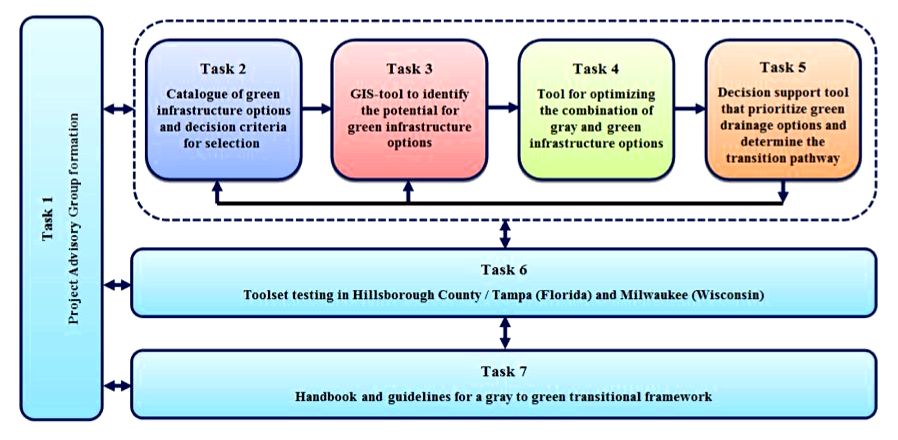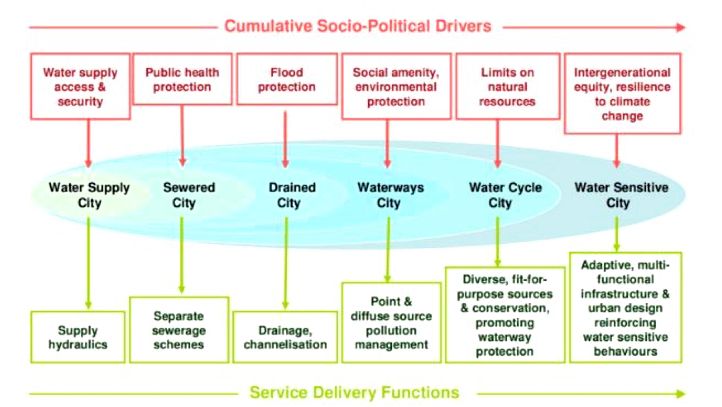Figure 1: Urban Water Management Transitioning [Source: Brown et. al., 2008]
The need for transitioning of Urban Infrastructure Systems (UIS) is illustrated by the facts that the earth system is undergoing significant rapid changes which have developed from increased human activities, population growth and urbanization (Vairavamoorthy et al., 2008). Whereas 48% of the world’s population presently live in cities and towns, this proportion is expected to increase to about 60% in the year 2030 aggravating the need for the transition of existing systems. Further more in developing countries the urban population is predicted to grow from 1.9 billion in 2000 to 3.9 billion in 2030, averaging 2.3% per year. In addition in developed countries, the urban population is expected to increase, from 0.9 billion in 2000 to 1 billion in 2030 with an overall growth rate of 1%. On the other hand, existing infrastructure systems have been gradually deteriorating due to environmental action and ageing; in many cases significantly exceeding their design life leading to failure to meet the minimum level of service.
With increasing global change pressures cities of the future will experience difficulties in efficiently managing scarcer and less reliable UIS. In order to meet these challenges there is a need for a fundamental change in the way we manage urban infrastructure. The current models of urban infrastructure systems, and their corresponding infrastructure, originates from the 19th century, when populations were relatively small, and there was a view that resources were in abundance and the environment benign. Today, cities all over the world are facing a range of dynamic regional and global pressures, such as climate change, population growth, urbanization, deterioration of urban infrastructure systems and more. Due to these pressures cities of the future will experience difficulties in efficiently managing these infrastructure systems.
To ensure a more sustainable future there is a need for more drastic measures. Technology breakthroughs and innovative designs need to be coupled with comprehensive system changes to the urban processes, institutions, and regulations that ultimately shape our cities. Cities will be faced with difficult future strategic decisions (e.g. the choice between centralized and the decentralized systems; the choice regarding the level of involvement of individual citizens, NGOs and companies; the choice between an institutional framework where separate institutions are responsible for a certain element of the urban infrastructure system or moving towards a more integrated institutional set-up). Hence it is likely that future desired UIS will look and operate differently to existing ones and will be managed and financed differently.
A major challenge for most cities will be to establish a process for transitioning from their present situation to the desired future endpoint (transitioning describes the path taken to get from the present situation to the desired future state). Transitioning can be viewed as the long term phased gradual change of the state of a system leading to a radically new system (optimized future system).
Focus Area
Title: ’From Gray to Green: Tools for Transitioning to Vegetation-Based Stormwater Infrastructure’.
Funder: US Forest Service, National Urban and Community Forestry Challenge Program.
Goal: This project is will provide natural resource managers, planners, and engineers with a set of decision support tools to aid the strategic planning process for transitioning to green infrastructure systems that emphasize trees and urban forests.
Project Description
Many cities recognize the potential of green infrastructure in managing and mitigating urban stormwater runoff (e.g. nutrient load), yet most lack systematic strategies for transitioning away from their existing conventional (gray) drainage systems. Policy makers and their constituents are becoming increasingly aware of the ecological, economic, and social benefits offered by urban forests. Urban foresters are now finding themselves charged with the task of managing city trees for specific ecosystem services. A recent focus is the use of trees as part of green infrastructure stormwater best management practices (green BMPs) to manage water quality and to achieve environmental management goals such as nutrient reductions required in total maximum daily loads (TMDLs).
Total nitrogen and phosphate loads in urban runoff are important non-point source pollutants that often lead to eutrophication and associated water quality problems in receiving water bodies. Recent research findings indicate that green infrastructure BMPs that include urban trees and urban forests provide a viable and cost-effective strategy for managing nitrogen and phosphorus pollution in urban runoff. Some of the BMPs involving mature vegetation have been proven to be more effective than conventional ’gray’ stormwater BMPs to manage nutrient pollutants in urban runoff. In addition to this stormwater function, green infrastructure strategies that emphasize trees and urban forests provide a range of social and ecological benefits not offered by traditional ’gray’ infrastructure systems. Hence there is a call to promote green infrastructure options that include trees and urban forests as stormwater BMPs.
Up to now the application of green BMPs and the supporting research are mainly focused on new urban development sites, neglecting the potential for green infrastructure in existing urban areas. It is generally easier to implement innovative green BMP solutions in new developments where there are no limiting inherited infrastructures. The downside of this strategy, if restricted in this manner, is that green infrastructure will have limited application in many of the nation’s largest communities. Widespread adoption of green drainage infrastructure can only be achieved if the inherited conventional urban stormwater systems are gradually replaced by green infrastructure. This transition process is complicated as many municipalities feel that they are locked in by the existing conventional infrastructure and hence instinctually opt to replace and repair aging conventional systems rather than develop and implement green BMP solutions.
The transition from gray to green infrastructure for urban stormwater management and the promotion of green BMPs that emphasize tree and urban forests can only be achieved with the collaboration of urban foresters, engineers, planners, and environmental managers. Currently this collaboration is constrained by a lack of information exchange and differences in the management and design cultures of the involved disciplines. For example, traditional civil engineers often rely on the well-known costs and longevity of traditional ’gray’ infrastructure and tend to avoid the more uncertain and variable performance of green BMPs, even if they hold promise as efficient and cost-effective solutions. A successful transition from gray to green infrastructure requires bridging the gap between the disciplines. Decision support tools are needed to share information and to guide a collaborative planning process in a clear and accountable manner.
Project Objective
The main objectives of this research include:
- Development of a catalogue of stormwater BMPs options with an emphasis on urban trees and forests – providing their cost, performance metrics and site selection criteria.
- Identification of the potential to implement green infrastructure BMP options in developed urban areas with existing conventional drainage systems.
- Identification of the optimal combination of existing conventional gray drainage systems and new green BMP options that improves the performance at the lowest cost.
- Development of a decision support tool to identify the preferred transition pathway from gray to green infrastructure.
- Application of the tools in two demonstration projects with different climatic conditions to illustrate the national applicability of the toolset.
- Development of a transitioning framework that facilitates the transitioning process from gray to green drainage systems across the nation.
Project Activities
This project will develop and demonstrate an innovative transitioning framework from gray to green infrastructure systems for urban watersheds through the execution of the tasks outlined below and illustrated in figure 2.

Figure 2
Project Deliverables
This project proposes the development of a suite of decision-making tools that will help reduce disciplinary barriers and support the transition from gray to green infrastructure. With an emphasis on user-friendliness, the toolset will make existing models and green infrastructure literature accessible to a wide interdisciplinary audience. Proposed products include:
- GIS-tool to identify the potential to implement green BMPs, including urban trees and forests, in catchments with existing conventional stormwater systems.
- Optimization tool to identify an optimal combination of existing gray and new green infrastructure considering water quality control and other environmental / social benefits.
- Decision support tool to prioritize implementation of green BMPs, and determine the most effective transition pathway from gray to green infrastructure.
- Case studies to test and demonstrate the effectiveness of the transition framework and toolset through its modeled application in urban catchments in the City of Tampa and Hillsborough County (Florida), and City of Milwaukee (Wisconsin).
- Support documentation (publications and video sequences) for proposed toolset.
Resourse:https://www.usf.edu/pcgs/research-and-initiatives/transitioning-urban-infrastructure.aspx Key:Research Initiatives
